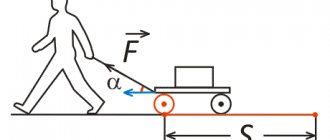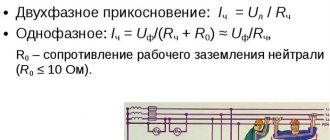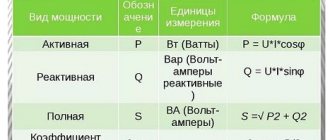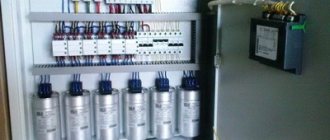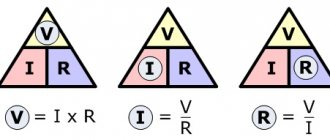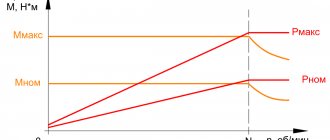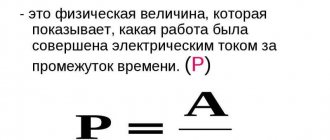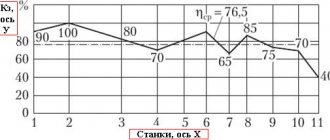In a general sense, this term refers to energetic changes in a particular system. The classic formula of mechanical power establishes the relationship between work and the time it took to complete the corresponding process. This publication additionally discusses electrical and hydraulic energy parameters, calculation methods, and measuring instruments.
Mechanical power characterizes the speed at which work is performed
Current power through the capacitor
Let an alternating voltage be applied to the capacitor. As we know, the current through a capacitor is ahead of the voltage in phase by:
For instantaneous power we get:
A graph of instantaneous power versus time is shown in Fig. 3.
Rice. 3. AC power through capacitor
What is the average power value? It corresponds to the “middle” of the sinusoid and in this case is equal to zero! We see this now as a mathematical fact. But it would be interesting to understand from a physical point of view why the current power through the capacitor turns out to be zero.
To do this, let's draw graphs of voltage and current in the capacitor over one oscillation period (Fig. 4).
Rice. 4. Voltage across the capacitor and current through it
Let's consider all four quarters of the period sequentially.
1. First quarter
, . The tension is positive and increasing. The current is positive (flows in the positive direction), the capacitor is charged. As the charge on the capacitor increases, the current decreases.
Instantaneous power is positive: the capacitor stores energy coming from the external circuit. This energy arises due to the work of an external electric field that pushes charges onto the capacitor.
2. Second quarter
, . The tension remains positive, but is subsiding. The current changes direction and becomes negative: the capacitor is discharged against the direction of the external electric field. At the end of the second quarter, the capacitor is completely discharged.
Instantaneous power is negative: the capacitor releases energy. This energy returns to the circuit: it is used to do work against the electric field of the external circuit (the capacitor, as it were, “pushes” the charges in the direction opposite to the one in which the external field “wants” to move them).
3. Third quarter
, . The external electric field changes direction: the voltage is negative and increases in magnitude. The current is negative: the capacitor is charging in the negative direction.
The situation is completely similar to the first quarter, only the signs of voltage and current are opposite. The power is positive: the capacitor again stores energy.
4. Fourth quarter
, . The voltage is negative and decreases in magnitude. The capacitor is discharged against the external field: the current strength is positive.
Power is negative: the capacitor returns energy to the circuit. The situation is similar to the second quarter - again with the replacement by replacing the signs of current and voltage with opposite ones.
We see that the energy taken by the capacitor from the external circuit during the first quarter of the oscillation period is completely returned to the circuit during the second quarter. This process is then repeated again and again. This is why the average power consumed by a capacitor turns out to be zero.
AC power
The author of the article is a professional tutor, author of textbooks for preparing for the Unified State Exam Igor Vyacheslavovich Yakovlev
Topics of the Unified State Examination codifier: alternating current, forced electromagnetic oscillations.
Alternating current carries energy. Therefore, the issue of power in the AC circuit is extremely important.
Let and be the instantaneous values of voltage and current in a given section of the circuit. Let's take a short time interval - so small that the voltage and current will not have time to change any during this time; in other words, the values and can be considered constant during the interval.
Let a charge pass through our section over time (in accordance with the rule for choosing the sign for the current strength, a charge is considered positive if it is transferred in a positive direction, and negative otherwise). The electric field of moving charges performed work
Current power is the ratio of the work done by the electric field to the time during which this work is done:
We received exactly the same formula at one time for direct current. But in this case, power depends on time, oscillating together with current and voltage; therefore quantity (1) is also called instantaneous power
.
Due to the presence of a phase shift, the current strength and voltage in the area do not have to coincide in sign (for example, it may happen that the voltage is positive and the current strength is negative, or vice versa). Accordingly, power can be either positive or negative. Let's look at both of these cases in a little more detail.
1. Power is positive
: 0′ class='tex' alt='P > 0′ /> .
Voltage and current have the same signs. This means that the direction of the current coincides with the direction of the electric field of the charges forming the current. In this case, the energy of the section increases: it enters this section from an external circuit
(for example, the capacitor is charged).
2. Power is negative
: . Voltage and current have different signs. Therefore, the current flows against the field of moving charges that form this very current.
How can this happen? It’s very simple: the electric field that arises in the area, as it were, “outweighs” the field of moving charges and “pushes” the current against this field. In this case, the energy of the section decreases: the section gives off energy to the external circuit
(for example, the capacitor is discharging).
If you don’t quite understand what was just discussed, don’t worry - further on there will be specific examples in which you will see everything.
Electric current power concept
The concept of power is closely related to the amount of work that an electric current can perform over a set period of time. The work of current is to convert electricity into other types of energy - mechanical, kinetic, thermal and others. Therefore, power, in its essence, represents the speed of all these transformations.
Indicators - power and voltage are encountered constantly in everyday life in areas where electrical devices are used. All of them consume a certain amount of electric current, so before starting operation their potential capabilities, parameters and technical characteristics must be taken into account.
The power value of the devices used is required in order to calculate the cross-sections of cables and wires, ratings of circuit breakers and other protective equipment. In addition, it becomes possible to calculate in advance how long a particular job can be completed.
To perform the calculations, the formula used is P = A/t, where A is the work and t is the set period of time. There are two types of power - active and reactive.
Power via engine displacement
It is not always possible to determine the engine torque. Sometimes car owners do not even know the meaning of this parameter. In this case, the power of the engine unit can be determined using the engine volume.
To do this, you will need to multiply the volume of the unit by the crankshaft speed, as well as by the average effective pressure. The resulting value must be divided by 120:
P = (V * n * Peffective)/120 where V – engine volume, n – crankshaft rotation speed [rpm], Peffective – average effective pressure, 120 – constant, proportionality coefficient.
This is how the power of a car engine is calculated using the volume of the unit.
Most often, the Peffective value in standard gasoline engines varies from 0.82 MPa to 0.85 MPa, in forced engines - 0.9 MPa, and in diesel units the pressure value ranges from 0.9 MPa to 2.5 MPa.
When using this formula to calculate the actual power of the motor, to convert kW to hp. s., it is necessary to divide the resulting value by a coefficient equal to 0.735.
This calculation method is also far from the most complicated and takes a minimum of time and effort.
Using this method, you can calculate the power of the pump motor.
Hydraulic power
You can find out the performance of an asynchronous pump motor by an indirect method, based on the work performed. To do this, multiply the measured (input/outlet) pressure difference (ΔP) by the amount of pumped liquid (V) per cubic meter. in a second.
Example:
- pressure according to pressure gauges – 220 kgf/cm2;
- productivity – 65 l/min. = 3.9 cu. m/hour = 0.001083 cubic meters m/s.;
- power NH = ΔP * V = 220 * 100 (conversion cm to m) * 0.001083 = 23.83 kW.
Electric motor design
Drive includes:
- Rotor.
- Stator.
- Bearings.
- Air gap.
- Winding.
- Switch.
The rotor is the only moving part of the drive that rotates around its axis. The current passing through the conductors forms an inductive disturbance in the winding. The generated magnetic field interacts with the permanent magnets of the stator, which causes the shaft to move. They are calculated using the formula for electric motor power by current, for which the efficiency and power factor are taken, including all the dynamic characteristics of the shaft.
Bearings are located on the rotor shaft and contribute to its rotation around its axis. The outer part is attached to the engine housing. The shaft passes through them and comes out. Since the load extends beyond the working area of the bearings, it is called overhanging.
The stator is a stationary element of the electromagnetic circuit of the engine. May include winding or permanent magnets. The stator core is made of thin metal plates called the armature package. It is designed to reduce energy loss, which often occurs with solid rods.
Air gap is the distance between the rotor and stator. A short gap is effective, as it affects the low efficiency of the electric motor. The magnetizing current increases with increasing gap size. Therefore, they always try to make it minimal, but to reasonable limits. Too small a distance leads to friction and weakening of the fixing elements.
The winding consists of copper wire assembled into one coil. Typically laid around a soft magnetized core consisting of several layers of metal. The induction field is disturbed when current passes through the wires of the winding. At this point, the installation enters configuration mode with explicit and implicit poles. In the first case, the magnetic field of the installation is created by a winding around the pole piece. In the second case, the slots of the rotor pole piece are dispersed in the distributed field. A shaded pole motor has a winding that inhibits magnetic disturbance.
The switch is used to switch the input voltage. It consists of slip rings located on the shaft and isolated from each other. The armature current is supplied to the contact brushes of the rotary commutator, which causes a change in polarity and causes the rotor to rotate from pole to pole. If there is no voltage, the motor stops turning. Modern installations are equipped with additional electronic means that control the rotation process.
Average active power of lighting devices
The number of operating hours of the lighting load per year (lamp burning time) can be determined by the formulas:
Working Light:
emergency lighting:
outdoor lighting:
Where: T1, T1/,T1// - duration of lighting operation on the longest winter night (December 23), T2, T2/,T2// - duration of operation on the shortest summer night (June 23), TP - additional connection time lighting on gloomy days.
For practical calculations, you can also use the lighting data given in the table below:
The load at the entrance to the building, as well as the load of the lighting supply line, is determined by multiplying the lighting power RO by the demand coefficient Ks. If the demand coefficient cannot be determined by research, it can be accepted:
1 – for lines that feed individual group panels, as well as for small industrial buildings;
0.95 – buildings consisting of separate large spans;
0.85 – buildings that consist of many industrial premises;
0.8 – engineering - laboratory and administrative - household buildings and others;
0.6 – cascading buildings, which consist of many separate rooms;
Formulas for measurement
Power is a quantity that is directly related to other indicators. Thus, it is directly related to time, force, speed, force vector and speed, force and speed modulus, torque and rotation frequency. Often, in formulas when calculating the electrical power type, the number Pi, the resistance indicator, instantaneous current with voltage in a specific section of the electrical network, active, total and reactive power are also used. A direct participant in the calculation is the amplitude with angular velocity and the initial current strength with voltage.
In the calculations of the hydraulic power type, pressure and fluid flow take part. Often the number of engine revolutions for a specific period of time is taken into account.
Additional Information! To calculate thrust, efficiency with other operating parameters of the device, temperature, friction force and conductive resistance with reactive loads are studied.
Basic formulas for measurement
Power of rotating objects
To calculate such a system, use the formula:
N = M * w = (2π * M* n)/60,
Where:
- M – moment of force;
- w – angular velocity characterizing rotation;
- n is the number of revolutions that an engine or other device makes in 60 seconds.
The information provided is used taking into account the intended purpose and actual conditions. Thus, in thermodynamics it is necessary to remember that the efficiency of the system depends on the ambient temperature. The heat loss of the heater is estimated by the corresponding power per unit surface area. The same is done when solving mechanical problems to calculate thrust, efficiency, and other operating parameters. As a rule, it is necessary to compensate for friction with a special coefficient.
In electrical circuits, current limits the resistance of the conductor. For short distances at low power, careful calculations are not necessary. However, the highway project necessarily contains the corresponding calculations. Based on the results obtained, conclusions are drawn about average annual economic indicators. It should be remembered that it is necessary to take into account the distortions that reactive loads add when working with alternating voltage.
Motor torque
Power
relates torque to speed to determine the total amount of work that must be done in a given period of time.
Let's look at the interaction between torque, power and speed, and their relationship with electrical voltage, using Grundfos electric motors as an example. Electric motors have the same power rating at both 50 Hz and 60 Hz.
This entails a sharp reduction in torque at 60 Hz: 60 Hz causes a 20% increase in speed, which leads to a 20% decrease in torque. Most manufacturers prefer to specify motor power at 60 Hz, so as line frequency drops to 50 Hz, motors will produce less shaft power and torque. Electric motors provide the same power at 50 and 60 Hz.
A graphical representation of the torque of the electric motor is shown in the figure.
The illustration represents a typical torque/speed characteristic. The following are terms used to describe the torque of an AC motor.
Starting torque (MP): Mechanical torque developed by the electric motor on the shaft during start-up, i.e. when current is passed through an electric motor at full voltage while the shaft is locked.
Minimum Starting Torque (Mmin): This term is used to refer to the lowest point on the torque/speed curve of an electric motor as the load is increased to full speed. For most Grundfos electric motors, the minimum starting torque is not specified separately, since the lowest point is at the locked rotor point. As a result, for most Grundfos motors the minimum starting torque is the same as the starting torque.
Blocking torque (Mblock): The maximum torque is the torque produced by an AC motor at rated voltage, supplied at rated frequency, without sudden changes in rotational speed. It is called the ultimate overload torque or maximum torque.
Full Load Torque (FLT): The torque required to produce rated power at full load.
Power: average and instantaneous
Author
:
–
The logic of our reasoning will be the same as when studying average and instantaneous speed.
Consider work as a function of time. Let A
(t)
be
the work done during time t.
A
(t+Δt) – work done in time (t+Δt).
Then [ A
(t+Δt) –
A
(t)]/Δt is the average power over the time period from t to (t+Δt). The limit of the sequence of values of such average powers at Δt→0 is instantaneous power, i.e. power at time t is the derivative of work with respect to time.
N
(t)=
=А'(t) (2.10.1)
Derive a special case when the power does not depend on time.
Student
:
– N
=
A
/t.
Author
:
–
Give an example where power is constant.
Student
:
–
This happens when the force acting on the body is constant.
Author
:
–
Wrong! See for yourself. Let us assume that the force accelerating the body is constant over time. Then from (2.10.1) it follows that
Part heating depending on resistance
When choosing a suitable resistor, you must pay attention to the temperature range at which correct operation of the part is possible. It is always specified by the manufacturer
In order for the resistor not to fail, timely release of heat into the atmosphere is necessary. The element must not overheat. The colder the air (within the acceptable range), the longer the component has a chance to last. Do not allow excess heat to accumulate near the resistor.
When the temperature indicator reaches its maximum within the range, the process of burning out the upper marked layer begins at the resistance. In this case, it is necessary to take measures to reduce the temperature, otherwise the product’s filling, which is responsible for resistance, will burn out and it will become completely unsuitable for further use.
If a part with the required dimension for a specific circuit is not found, you can use the option with a superior value if it suits the device being assembled. Resistors whose power data does not reach the required ones can be used in such a situation only by combining them in series. In general, knowledge of the effects of parallel and series connected resistor elements will be useful in a situation where there is no part with ideally suitable parameters at hand.
Rules for calculating power consumption
In everyday life, when the need arises to independently determine the power consumption of electricity, do the following:
- determine the voltage required to power the device;
- find out the rated current from the passport data.
How to find out the power of an electrical appliance if not a single parameter is known? Household electrical appliances are designed for 220 V.
To determine power, it is permissible to measure current consumption. This can be done using an ammeter. It is connected to the circuit in series, having previously set the highest measurement limit - at least a hundred amperes. Current clamp meters will help you easily measure current, for which one of the conductors is grasped by the clamp sensor, and the readings are displayed on the display. Knowing the voltage, multiply it by the measured current to obtain the amount of power consumed.
Clamp meter
Electric power
In this area, the weight of objects, frictional force, and other mechanical terms and definitions are not important. However, the essence of the physical quantity under consideration remains unchanged, the principles of individual calculations are similar.
You can use the formula to calculate instantaneous power:
Where:
- (ab) – denote the energy expended on moving charge (q) from one point to another;
- A is the work performed during this process.
If we take all the charges (Q), the voltage at the control points (U), it is easy to calculate the total power:
P = (U/ Δt) * Q = U * Q/ Δt = U *I.
The last transformation is based on the classical definition of current (the number of charges flowing through the corresponding conductor in a certain time).
For passive circuits, you can use Ohm's law and the corresponding formulas without additional corrections. Take into account (if available) the source of electromotive force (direction of current movement).
When connecting equipment to AC sources, calculations become more complicated. It is necessary to integrate instantaneous values taking into account certain periods, frequencies and waveforms. In practice, they often solve problems of calculating the power of consumers connected to a power source with a sinusoidal current (voltage).
The active component of energy in this case will depend on the phase shift. The value is calculated using the formula:
Pa = U * I * cosϕ (for 220V).
When working with three-phase sources, use a modified version of the expression:
Pa = √3 * U * I * cosϕ = 1.732 * U * I * cosϕ.
The reactive variable is consumed and returned to the power supply. For the calculation, take the following dependence of the basic parameters:
Full power:
Power power
To solve practical problems, change the considered expressions as necessary. Calculation of energy changes shows an example with a falling object:
- in the initial data, the height and weight of the body are known;
- you need to set the power of the force, the formula of which displays the result halfway through free fall;
- substitute known quantities for the basic components:
- F = m *g;
- V (velocity at a certain point) = Vn (initial velocity) + g*t.
- after the transformation is completed, you get:
P = m*√(g3*h).
How to find out what power is in an AC circuit
It is worth pointing out that this is a value that is directly related to other indicators. For example, it is directly dependent on time, force, speed, vector of force and speed, modulus of force and speed, moment of force and speed of rotation. Often in formulas when calculating electrical power, the number Pi is also used with the resistance indicator, instantaneous current, voltage in a specific section of the electrical network, active, total and reactive power. Direct participants in the calculation are the amplitude, angular velocity and initial current strength with voltage.
In a single-phase circuit
You can understand what power indicator is in a single-phase alternating current circuit by using a current transformer. To do this, you need to use a wattmeter, which is connected through a current transformer. The readings should be multiplied by the transformer current coefficient. When measuring power at high voltage, a current transformer is needed to insulate the wattmeter and ensure the safety of the user. The parallel circuit is not connected directly, but thanks to a voltage transformer. Secondary windings with housings of measuring transformer installations must be grounded to avoid accidental insulation damage and high voltage contact with devices.
Note! To determine the parameters in the network, it is necessary to multiply the ammeter by the transformer current coefficient, and multiply the numbers obtained by the voltmeter by the transformer voltage coefficient
In a three-phase circuit
In an alternating current circuit, the power indicator in a three-phase circuit can be determined by multiplying the current by the voltage. Since this is not a constant electric current, it depends on time and other parameters, so it is necessary to use other proven circuits. So, you can use a wattmeter.
The measurement must be carried out in only one phase and multiplied by three according to the formula. This method saves equipment and reduces measurement dimensions. Used for high precision measurement of each phase. In case of an asymmetrical load, you need to use the appropriate wattmeter connection diagram. This is a more accurate method, but requires three wattmeters.
Note! If the circuit does not provide for the presence of a neutral conductor, an appropriate circuit is also needed. It is worth pointing out that today you can measure the necessary indicators not only with an analogue, but also with a digital device
The difference between the second one is its reduced size and lightness. In addition, digital units have ways to record current with voltage, network cosine, and others. This makes it possible to monitor various quantities from a distance and transmit warnings if there is a deviation. This is convenient because you don’t need to measure current with voltage, and then, using formulas, calculate everything thoroughly
It is worth pointing out that today it is possible to measure the necessary indicators not only with an analogue, but also with a digital device. The difference between the second one is its reduced size and lightness. In addition, digital units have ways to record current with voltage, network cosine, and others. This makes it possible to monitor various quantities from a distance and transmit warnings if there is a deviation. This is convenient because you don’t need to measure current with voltage, and then, using formulas, calculate everything thoroughly.
In general, power is a quantity whose main purpose is to show the strength of a particular device and, in many cases, the speed of activity interacting with it. It can be mechanical, electrical, hydraulic and for direct current and alternating current. Measured according to the international system in watts and kilowatts.
What formula is used to calculate
Calculation of current strength by power and voltage in a DC network
To calculate the force I (current), the value U (voltage) must be divided by the value of resistance.
Current calculation by power and voltage:
Measured in amperes.
For such a case, electrical P (active power) can be calculated as the product of the electrical force I by the value U.
Formula for calculating power by current and voltage:
All components in these two formulas are characteristic of direct electric current and are called active.
Based on these two formulas, we can also derive two more formulas by which we can recognize P:
Single-phase loads
In single-phase alternating current networks, it is necessary to calculate separately for P and Q loads, then they must be added using vector calculus.
In scalar form it will look like this:
As a result, the calculation of P, Q, S looks like a right triangle. The two legs of this triangle represent the P and Q components, and the hypotenuse is their algebraic sum.
S is measured in volt-amperes (VA), Q is measured in volt-ampere-reactive (VAr), P is measured in watts (W).
Knowing the sizes of the legs for triangles, you can calculate the power factor (cos φ). How to do this is shown in the triangle image.
Calculation in a three-phase network
Alternating I (current) differs from constant in all respects, especially the presence of several phases. Calculation of P in a three-phase load is necessary to correctly determine the characteristics of the connected load. Three-phase networks are widely used due to ease of use and low material costs.
Three-phase circuits can be connected in two ways - star and delta. In all diagrams, the phases are designated by the symbols A, B, C. The neutral wire is designated by the symbol N.
When connected by a star, two types of U (voltage) are distinguished - phase and linear. Phase U is defined as the U between phase and neutral. Linear U is defined as U between two phases.
These two U are related by the relation:
Linear and phase electric currents when connected by a star are equal to each other: IЛ = IФ
Calculation form S for star connection:
S = SA + SB + SC = 3 × U × I
P = 3 × Uph × Iph × cos φ
Q = √3 × Uph × Iph × sin φ
.
When connected by a triangle, phase and linear U are equal to each other: UЛ = UФ
Linear I when connected by a triangle is determined by the formula:
Formulas for the power of electric current when connected by a triangle:
- S = 3 × Sph = √3 × Uph × Iph;
- P = √3 × Uph × Iph × cosφ;
- Q = √3 × Uph × Iph × sinφ.
Average P in active load
In electrical networks, P is measured using a special device - a wattmeter. Connection diagrams depend on the method of connecting the load.
With a symmetrical load, P is measured in one phase, and the result obtained is multiplied by three. In the case of an unbalanced load, three instruments will be required for measurement.
The P parameters of the electrical network or installation are important data for the electrical appliance. Data on P consumption of the active type are transmitted for a certain period of time, that is, the average consumed P for the calculated period of time is transmitted.
Different types of power
For the mechanical power formula, the following expression is used:
The numerator of the formula is the work expended, and the denominator is the time period for its completion. This ratio is called power.
There are three quantities that can be used to express power: instantaneous, average and peak:
- Instantaneous power is a power indicator measured at a given moment in time. If we consider the equation for power N = ΔA/Δt, then instantaneous power is that which is taken in an extremely small period of time Δt. If there is a plotted graphical dependence of power on time, then instantaneous power is simply the value read from the graph at any given moment in time. Another expression for instantaneous power:
Average power is a power value measured over a relatively long time period Δt; Peak power is the maximum value that instantaneous power can have in a particular system during a certain period of time. Stereos and car engines are examples of devices that can deliver maximum power well above their average power rating. However, this power level can be maintained for a short time
Although it may be more important for device performance than average power.
Important! The differential form of the equation N = dA/dt is universal. If mechanical work is performed uniformly over time t, then the average power will be equal to the instantaneous
From the general equation we get the following entry:
where A will be the total work done for a given time t. Then, with uniform operation, the calculated indicator is equal to the instantaneous power, and with uneven operation, the average power.
Jpg?.jpg 600w, 900w" sizes="(max-width: 600px) 100vw, 600px">
Formulas for mechanical power
How is mechanical power measured?
Mechanical work is always associated with the movement of bodies. And movement occurs in time. Therefore, the execution of work, as well as the transformation of mechanical energy, always occurs over a certain period of time.
Work performed over a period of time:
The simplest observations show that the time it takes to complete a job can vary. So, a schoolchild can climb the stairs to the fifth floor in 1-2 minutes, and an elderly person - in no less than 5 minutes. A KrAZ truck can transport a certain load over a distance of 50 km in 1 hour. But if a passenger car with a trailer begins to transport this load in parts, it will spend at least 12 hours.
To describe the process of doing work, taking into account its speed, a physical quantity called power is used.
What is power
Power is a physical quantity that shows the speed at which work is performed and is equal to the ratio of work to the time during which this work is performed.
Since energy is converted during work, we can assume that power characterizes the rate of energy conversion.
How to calculate power
To calculate power, you need to divide the work value by the time during which this work was performed:
If power is denoted by a Latin letter
, then the formula for calculating power will be as follows
Power units
The unit of watt (W) is used to measure power. With a power of 1 W, work of 1 J is performed in 1 s:
The power unit is named after the English mechanic James Watt, who made a significant contribution to the theory and practice of building heat engines.
James Watt (1736-1819) - English physicist and inventor.
Watt's main contribution is that he separated the water condenser from the heater and designed a pump to cool the condenser. In fact, he increased the temperature difference between the heater and the condenser (refrigerator), thereby increasing the efficiency of the steam engine. Later, Sadi Carnot would theoretically justify this.
He was one of the first to suggest that water is a complex substance consisting of hydrogen and oxygen.
Nominal speed
Another key indicator of the electromechanical characteristics of the engine is the shaft speed. It is expressed in revolutions per minute. It is often used in the pump motor power formula to find out its performance. But it must be remembered that the indicator is always different for idling and operation under load. The indicator represents a physical quantity equal to the number of full revolutions over a certain period of time.
Calculation formula for speed:
n = 30 × omega ÷ pi, where:
n — engine speed, rpm.
In order to find the power of an electric motor using the shaft speed formula, it is necessary to reduce it to the calculation of angular velocity. Therefore P = M × omega will look like this:
P = M × (2pi × n ÷ 60) = M × (n ÷ 9.55), where
t = 60 seconds.
Power formula
Power
of some force is a scalar physical quantity that characterizes the rate of work done by a given force. Power is often denoted by letters: N, P.
In the event that different work is performed in equal short periods of time, then the power is variable over time. Then enter the instantaneous power value:
where $delta A$ is the elementary work performed by the force, $Delta t$ is the length of time during which this work was performed. If instantaneous power is not a constant value, then expression (1) determines the average power over time $Delta t$.
The power of a force can be defined as the scalar product of the force and the speed at which the point of application of the force in question moves:
where $F_$ is the projection of the force $bar$ onto the direction of the velocity vector ( $bar$).
In the translational motion of a body of mass m under the influence of a force $bar$, the power can be calculated using the formula:
In the general case of arbitrary movement of a rigid body, the total power is the algebraic sum of the powers of all forces that act on the body:
where $bar_ $ is the speed of movement of the point to which the force $bar_ is applied
$.
In the case of translational motion of a rigid body with a speed of $bar$, the power can be determined using the formula:
where $bar$ is the main vector of external forces.
If a rigid body rotates around point O or around a fixed axis that passes through point O, then the formula for calculating power can be considered the expression:
where $bar$ is the main moment of external forces relative to point O, $bar$ is the instantaneous angular velocity of rotation of the body.
Power units
The basic SI unit of power is: [P]=W (watt)
What is engine power
Power should be understood as a physical quantity that shows the work performed by the engine per unit of time. In rotational motion, power is defined as the product of torque and the angular speed of rotation of the crankshaft. It is usually indicated in horsepower (hp), but it can also be measured in kW.
There are several units of measurement called "horsepower", but, as a rule, what is meant is the so-called "metric horsepower", which is equal to ≈ 0.7354 kW. But in the USA and Great Britain, horsepower in cars is equal to 0.7456 kW, that is, 75 kgf*m/s, which is approximately equal to 1.0138 metric.
- 1 kW = 1.3596 hp (for metric calculus);
- 1 kW = 1.3783 hp (English standard);
- 1 kW = 1.34048 hp (electric “horse”).
If we convert the power of 1 horsepower into kilowatts (in industry or energy), then it will be approximately equal to 0.746 kW. The concept of horsepower is not included in the International System of Measurements (SI), so measuring power in kW will be more correct.
Types of power
To determine engine characteristics, power concepts such as:
- indicator;
- effective;
- liter
The indicator power is the power with which the gases press on the piston. That is, no other factors are taken into account, but only the pressure of the gases at the moment of their combustion. Effective power is the force that is transmitted to the crankshaft and transmission. The indicator will be proportional to the average gas pressure on the piston.
There is also a parameter called liter engine power. This is the ratio of engine volume to its maximum power. For gasoline engines, the liter power is on average 30-45 kW/l, and for diesel engines - 10-15 kW/l.
How to find out the power of a car engine
Of course, the value can be found in the documents for the car, but sometimes you need to find out the power of a car that has been tuned or has been in operation for a long time. In such cases, you cannot do without a dynamometer. It can be found in specialized organizations and at service stations. The car's wheels are placed between drums that create resistance to rotation. Next, movement with different loads is simulated. The computer itself will determine the engine power. It may take several attempts for a more accurate result.
Units
How is power measured?
In the current internationally approved SI system of units, power is proposed to be indicated in watts (one W = 1 Joule of work done in 1 second). It is recommended to remove the outdated designation “horsepower” from circulation. For convenience, derived values with certain prefixes are used (one kilowatt (1 kW) = 10 to the third power of watt = 1,000 W).
Conversion of 1 W to other notations:
- kilogram-force-meter per second (kgf*m/s) – 0.102;
- erg per second (erg/s) – 107;
- horsepower (hp) metric / English - 1.36 * 10-3 / 1.34 * 10-3.
For your information. If the car description says 125 kW, this is equivalent to 170 hp. (125*1.36=169.95).
Design voltage
It is also called nominal. It is a base voltage represented by a standard set of voltages, which are determined by the degree of insulation of electrical equipment and the network. In reality, it may differ at different points of the equipment, but should not exceed the maximum permissible operating conditions designed for the long-term operation of the mechanisms.
For conventional installations, rated voltage refers to the calculated values for which they are provided by the developer in normal operation. The list of standard network voltage is provided in GOST. These parameters are always described in the technical characteristics of the mechanisms. To calculate performance, use the formula for electric motor power by current:
P = U × I.
Current power in an arbitrary area
Now let's look at the most general case. Let there be an arbitrary section of the circuit - it can contain resistors, capacitors, coils. This section is supplied with alternating voltage.
As we know from the previous leaflet “Alternating current. 2", there is some phase shift between the voltage and current in this section. We wrote it like this:
Then for instantaneous power we have:
Now we would like to determine what the average power is. To do this, we transform expression (5) using the formula:
As a result we get:
But the average value is zero! Therefore, the average power turns out to be:
This formula can be written using the effective values (4) of voltage and current:
Formula (7) covers all three situations discussed above. In the case of a resistor we have , and we arrive at formula (3). For a capacitor and a coil, and the average power is zero.
In addition, formula (7) gives an idea of a very general problem associated with the transmission of electricity
It is extremely important that the consumer has as close to one as possible. Otherwise, the consumer will begin to return a significant part of the energy back to the network (which is completely unprofitable for him), and besides, the returned energy will be irrevocably spent on heating wires and other circuit elements
This is a problem faced by designers of electrical circuits containing electric motors. The windings of electric motors have large inductances, and a situation similar to a “clean” coil arises. To avoid useless circulation of energy through the network, additional phase-shifting elements are included in the circuit - for example, so-called compensating capacitors.
Active and reactive power
The concept of active power is the direct conversion of electric current into mechanical, thermal and other types of energy. This process is irreversible and cannot be reversed. To measure active power, there is a special unit - watt (W). The formula defines 1 W = 1 volt x 1 amp. In everyday life and in production, higher values are used - kilowatts and megawatts.
Unlike active power, reactive power is created due to the load arising in capacitive or inductive devices. When alternating current is used to determine this indicator, there is a formula Q = U x I x sin φ. In this case, sin φ represents the phase shift, which produces a reduced voltage and operating current. The angle itself has a value in the range of 0-90 degrees or from 0 to minus 90 degrees. Volt-amps are used to measure reactive power.
Inductive and capacitive elements contribute to the return of electricity back to the network. As a result of shifts in voltage and current parameters, some overloads and other negative phenomena may occur in the electrical network. This is especially pronounced in capacitors, which release back all the accumulated charge. At such moments, a reverse movement of voltage and current occurs, shifted relative to each other.
The energy of capacitance and inductance, phase-shifted relative to the network’s own characteristics, is precisely reactive power. It is compensated by the reverse effect, preventing losses in the efficiency of power supply.
External speed characteristic (VSCH)
The external speed characteristic of the engine shows the dependence of power, fuel consumption and torque on the crankshaft speed. All these parameters are shown graphically in the form of curves.
External speed characteristic
In the figure you can see curves with the designations Pe - engine power, Me - torque, ge - specific fuel consumption. As you can see, with increasing speed and power, fuel consumption increases. The torque increases to a certain level and then decreases. At the point where the engine torque and power are most efficient, there will be the most optimal fuel consumption.
Motor manufacturers are fighting to ensure that the engine develops maximum torque in the widest possible speed range (“the torque plateau is wider”), and maximum power is achieved at speeds as close as possible to this shelf. Such an engine will pull you out of the swamp and allow you to accelerate quickly in the city.
The external speed characteristic evaluates the dynamic characteristics of the car, determines efficiency and fuel consumption for different parameters.
Measuring instruments
To measure power, a wattmeter, voltmeter, varmeter and multimeter with tester are used. They are widely used in various fields of energy with industry, communications, transport, science, medicine and everyday life. In everyday life, they are used to calculate the electrical energy consumed and calculate possible damage to the diodes. It is worth noting that all existing measuring instruments are divided into panel with portable and stationary, indicating with recording, evaluating and comparing.
The listed devices are connected in parallel to the load or source of electricity. Wattmeters with varmeters differ from others in that they can determine an indicator in an electromagnetic signal. They are divided into those designed for measuring low and high frequencies. As for voltmeters, they are analog, digital, liquid-compensated, pulse, phase-sensitive and selective.
Multimeters are combined devices. They, like voltmeters, are divided into digital and analog. They are used to calculate both voltage and electrical capacitance with inductance, temperature, current and resistance.
Wattmeter as the main measuring instrument for electrical appliances
